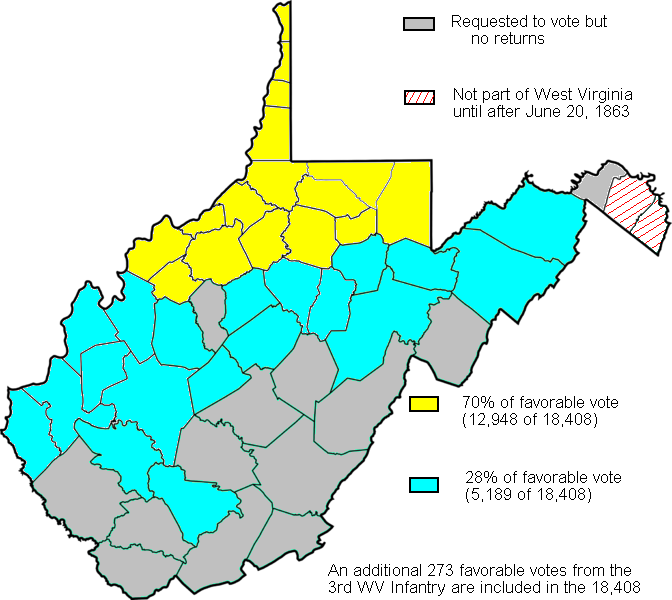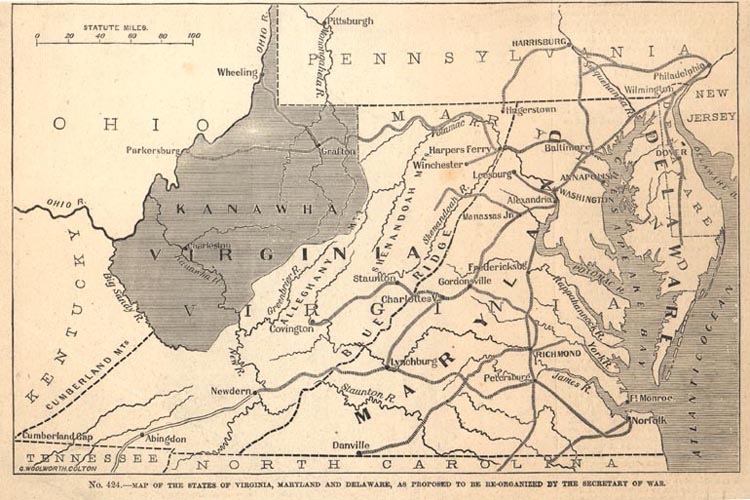
The Seal of the State of West Virginia.
On 20 June 1863, a new state of "West Virginia" was carved from the boundaries of the Commonwealth of Virginia.
The Convention in Richmond, Virginia had voted against secession prior to the action at Fort Sumter, and President Lincoln's call for troops to invade the South. Those events, however, and the administration's requirement that Virginia raise troops to coerce the Cotton States to remain in the Union, were enough to convince the convention to reconsider, and vote to secede -- this in April 1861. The convention, of course, required that their vote be ratified by a popular referendum, which it was in May 1861. A number of the counties in Virginia along the Ohio River, however, had opposed this move, and in both the vote in the Convention and the Referendum, they had voted against the move. When Virginia's place within the Confederacy was secure, delegates for these Unionist counties began separate meetings to discuss the possibility of seceding from Virginia! A Convention of delegates had met in Wheeling, on the Ohio, on 13 May 1861, prior to the referendum.

Wheeling, West Virginia, on the Ohio River. Meeting place of the Conventions that led to the formation of a new state.
With the overwhelming support of secession from the Union voiced in that popular referendum on 23 May 1861, (unelected) delegates from the western counties met again in Convention at Wheeling, this on 11 June 1861, where they decried the validity of secession. They also nominated Francis Pierpont to be "governor of Virginia" as they claimed to form a reorganized government of Virginia.

Results of the Referendum on West Virginia Statehood. Notice Berkeley and Jefferson county in the far eastern corner of the state. They would be the focus of the Virginia v. West Virginia case.
In August 1861, the Wheeling Convention called for a referendum in the western counties on the question of forming a new state. On 24 October 1861, that vote would be held, though turnout was much smaller than the secession referendum had been in May, and occupying Union troops were eager to help oversee the vote.

1862 Map showing the proposed state of Kanawha. It would be enlarged and dubbed "West Virginia."
The vote being favorable to a new state, work began in November to draft a new Constitution, a job that would be complete in February 1862. The new Constitution was ratified in April 1862. West Virginia would seek admission as a new state in December 1862, and President Lincoln, on the condition that they insert a clause phasing out slavery in their constitution, approved the request.
On 20 June 1863, West Virginia was admitted as a state of the United States -- the 35th state. Of course, the state would include a number of counties that had not voted to leave the Commonwealth of Virginia, but, in order to form a state of sufficient size, many occupied counties were included regardless.
West Virginia was a legal oddity. The federal Constitution states in Article IV, Section 3: "New States may be admitted by the Congress into this Union; but no new States shall be formed or erected within the Jurisdiction of any other State; nor any State be formed by the Junction of two or more States, or Parts of States, without the Consent of the Legislatures of the States concerned as well as of the Congress." Clearly the General Assembly in Richmond had not authorized the formation of this new state from Virginia -- but the Lincoln administration considered the Richmond Legislature to have forfeit its authority by participating in secession from the Union. The Pierpont government, and the Wheeling Convention, then, was the Union-recognized government of Virginia, and its permission was the basis of forming a new state. Indeed, Pierpont would move to Alexandria after the formation of West Virginia to remain within "his state." He would oversee those areas that Union troops occupied. Government "by the people," indeed.
A legal challenge did come after the war, in 1870, and focused on the panhandle counties of Berkeley and Jefferson, which were added to West Virginia after its initial formation. Virginia challenged the legitimacy of the referendums in those counties that chose to join West Virginia. The Supreme Court, in Virginia v. West Virginia ruled in favor of West Virginia retaining those counties, regardless of the circumstances of the referendums there. This also affirmed the legal existence of West Virginia as a state, though that question was not the direct focus of the court in that case.
The full text of that decision is here: http://supreme.justia.com/cases/federal/us/78/39/case.html
West Virginia, then, is a monument to the Lincoln administrations unique approach to law and a punishment for Virginia's role in the Confederacy. Convenient interpretations of law and coercive tactics, in the end, carried the day. If Virginia is Abraham, Kentucky is Isaac and West Virginia Ishmael.
Still, West Virginia, for its legally troubling birth, is today a beautiful state home to many great folks. Happy Birthday, West Virginia.
Live well.
Trivia Question: What state located ADJACENT to West Virginia was admitted to the Union as the 48th state?
ReplyDelete